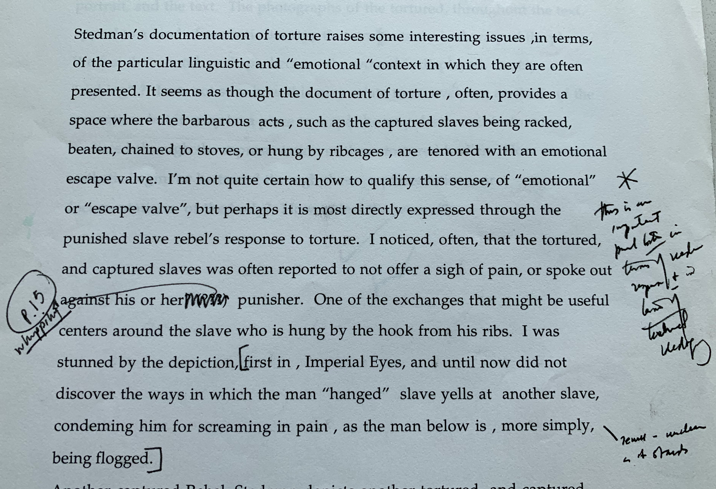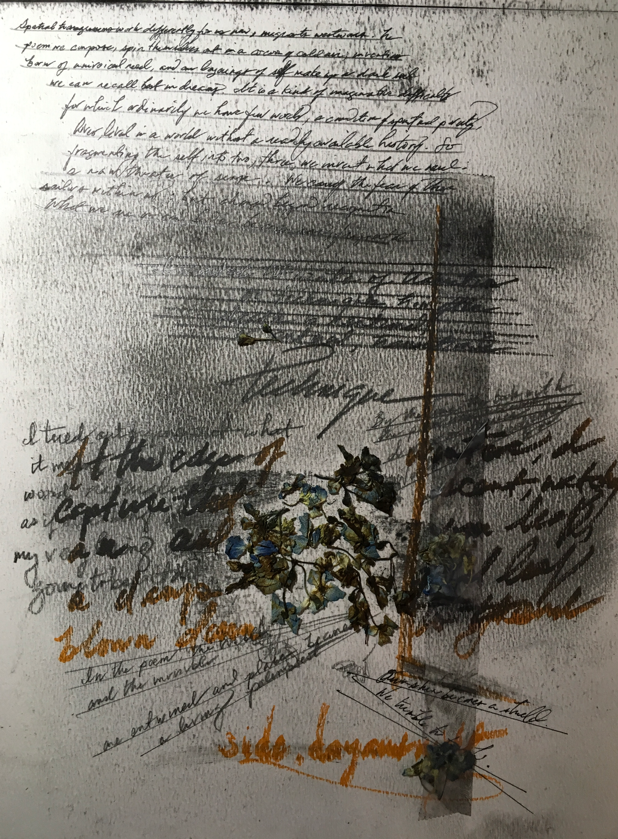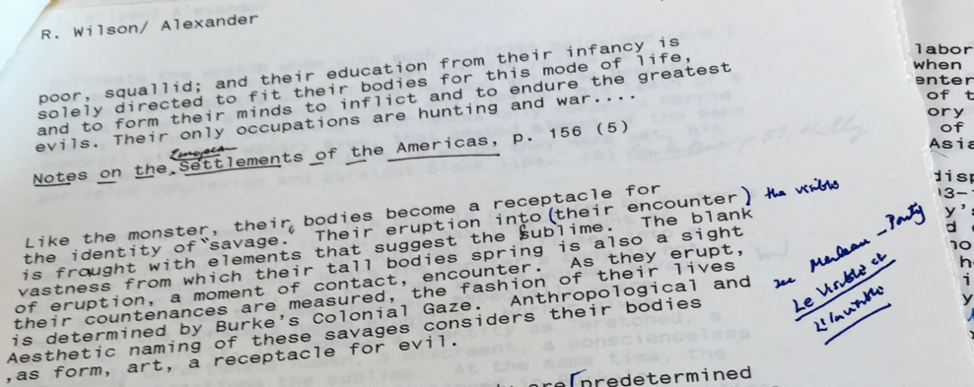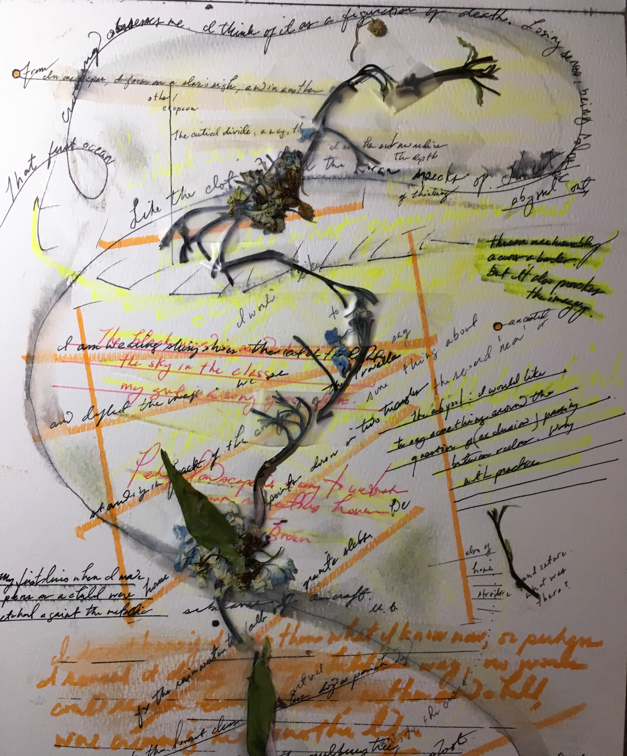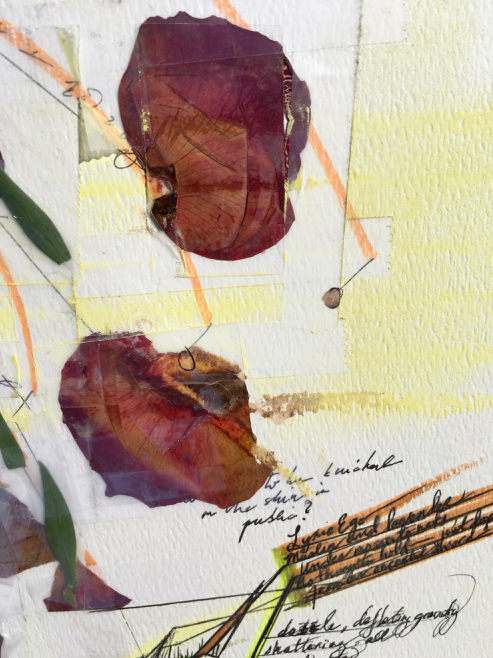Figures From the Blue Heron to Below as Above

for Meena Alexander
The Blue Heron’s Walk
At Vista Point, the men meet under the cover of the low tree that blots the fence on the slope of a hill upon which the sun exposes through the leaves, its base, and bodies shift near the trunk. There’s cement, too, cracked, and a concrete bench, high up at the plateau, near the parking lot where some of the men wait. Out of this, a Blue Heron comes, following me, as if to say, I am here, and I am leaving.
The day before, Adam would call to say in the pitch dark, your condition turned, the clot in the leg, the swelling, so walking would be gone, too—out of which the great bird moves into the morning forward, neck like a thick black snake, beak ebbed out as if hunting, the bend of its back, my own stretched, after the redeye kinks, but before I tell Adam: tell your mother I’m going on a pilgrimage to see her—he says his mom looks like a baby Buddha.
In the small hospital room, black spot on the blue wing, I want to choreograph a dance, one in which my shoulder drops and I dip forward, my fingers cut the air, and I feel your hand’s warmth in mine, wings folded into the body, puncturing between sorrow and light.
In “Writing Space,” in A Poetics of Dislocation, Meena Alexander writes, “A woman’s body tracked through space, intact and bloodied, drawing out bit by bit in lived time, blossoming words, rare geographies of longing.” Before I would actually begin to write my dissertation, I looked over another Vista, Scenic Area, on the other side of the country. It was then that Meena told me, for the first time, to stop writing poems; to instead finish my dissertation, so that my father, who was suffering, then, from dementia would attend and remember the day of my graduation.
He wore an H&M suit jacket then, one of mine, that neither of us would fit now. What I recall as I write are these instances, one’s in which my father was looking back at never knowing himself as the same person, again, and I am looking out across the dip of a valley, remembering a place in which I want to remember you, before Dallas and I buy a house, so very expensive, but ours, behind its small front yard, made of low, green shrubs, a red fire lane curves around the perimeter—I would finish my dissertation that summer.
In perhaps her last interview, “The Music of Words,” Alexander discusses poetic structure in relation to content, describing how the poem provides a gap where meaning is made, explaining:
I think the poem [is] almost like an act of tenderness that can return us to the earth that we’ve been severed from, so there’s something in that gap or that space where the poem exists that might allow us to make sense, very precariously…I suppose that [this] in the end is the function of art, that it takes us out of where we are and then returns us, in a way—that is transformative…
So that somewhere between Meena’s living and my remembering, here, is the act of looking to return to the Blue Heron’s walk, the choreography of its body, a body that, in some senses, I trace after the night into the blue, whitening morning when I held your hand as you moved between forms, and I think, now, about what you said when I said I was working on poems and not my dissertation: Don’t worry, all of the parts need to work together.
Breath
I wrote this paper for you, and saved it—these notes were among the first, of many, you would give me, circa 1997, your marks, however illegible, are what I want to return to now, the ink and edges, border notes I couldn’t quite always make out until we spoke, and even now on the redeye back over the country, I look again, close, decipher, and think.
Dot matrix strips gone leave striated memories, how you taught me to think about questions of racialized violence and the history of spectacle as we looked at the etchings of William Blake in conversation with John Stedman’s accounts of Suriname, rebel black bodies, not slaves, but caught human beings, gored, rib-cage-hooked, a reconfiguration, to write something about what I was learning through your teachings on Romanticism, Empire, and the Colonial Sublime, via Edmund Burke, vectors through which I would learn to work through the pitch of the body as a site of violation, however broken—tracked—however inured.
From above:
this is an
important point,
both in terms
of reader response &
in terms of textural
ideology.
Tense - unclear
as it stands.
Over 20 years later, I am still trying to say what I wanted to say then, or to think through something with you, about breath, about what’s communicated through what I thought of then as an emotional escape valve.
When you returned papers, you pulled us students aside, close, one by one, at the seminar table, leaving the last portion of class time, to explain what was and wasn’t clear. Perhaps I wanted to say what moved between torture, and its exchanges, learning how to understand the role of its voice in my work, the guttural, the condemned, and how to navigate the rhythm of an enduring violence, how to speak through it, and how to frame it, by argument.
When I arrive, David tells me your breathing has changed, significantly, and I can hear it, too, the end, which is only the strain of air, the clicks, how you look so radiant, and my heart is alert, in simply being with you, in that shifting light, each moment, that time, there, each walk—
I remember us walking in the streets around the Graduate Center, and all over the place, Central Park after your Yoga class, or after my swim, Downtown or Midtown as we stepped through questions, space, representation, form—we might have been leaving a show: William Pope.L in Chelsea, Ellen Gallagher at the Guggenheim, Kara Walker, or that time, Yoko Ono at MoMA.
In Central Park, you find a stick, take its tip and cut though the dirt, scratching out what you helped me to see, forever, grid in the soil to envision Gallagher’s work, as a poetic field, a way of helping me to understand, too, Gwendolyn Brooks’s poem, “A Bronzeville Mother Loiters in Mississippi. Meanwhile, A Mississippi Mother Burns Bacon,” or recently when you see some of my new paintings, water soluble pastels, pure graphite pencil, and found flora as the invisible architecture of a dissertation project as it continues to move, now, into something else, clicking, and fueling my work you helped guide, its first drawings into the soil.
Technique and Edges
For several weeks, in order to write this, I make collages, reading, again your work, but perhaps seeing and hearing it for the first time. I am guided by the Blue Heron, its walk, my fingers pointing and taking me through your words. I wanted, somehow, to think of the relationship between the bird’s bark in the distance, and the line in pencil I make. How did you manage to take us through so many layers of experience, Dear Meena? In “a world without a readily available history,” I am taken to remembering through marks, lines the dust of the graphite leading me to scissors, my cutting and pressing, and taping my small blue birthday flowers into the paper to blur into shadow, as I am taken by this in “Composition,” in Poetics of Dislocation:
In the poem, the visible and the invisible are entwined and place becomes a living palimpsest. The zone of the poem is where dreams cross language. And with the rhythms of composition the invisible enters.
I am interested, here, in the formative act, the role of the student learning from the teacher, and the student, for whom, in the end, is taught to see someone live, greatly, and someone die, so quietly, and to feel between these realms, the gift of its beauty, and touch.
At your burial ceremony, Kimiko asks us to name what we hear, or think, or see, I can’t recall it all, but am listening to something, there, out in the distance in the meadow, where we all are, something I will never forget, a way back in, something that I want to return to, technique.
Where in the rhythms of composition the invisible enters, I watch the night turn into morning, marking the transition between what moves between what’s layered, words in the memoir copied, the lines pressed, what collects at the fingertips, the shine of pure graphite at the edges of my fingerprints: the world of these vectors, moving across the imagination requires a way to move across this terrain.
Here, in another marked paper, this one on Mary Shelley’s Frankenstein, I read Edmund Burke’s Notes on the Settlements of the Americas as a text to help understand Shelly’s monster via an entirety of people buried under the earth, emerging, brown spawn, coming into view, and now I think about how you told me once, that some of my colleagues don’t ever even look at me.
So the student says, how still, the grace and depth of being, to be passed at, or made to feel some kind of way, the good fight being such that the understanding is that to be seen has little to do, or everything with the source work of making art and/as critique.
I would later read Merleau-Ponty, and think about the body, their many moves, its extensions from the corpus to what’s produced, and the ways that the distance then—Frankenstein’s super-bounding across the ice—for me, was like Eliza’s escaping to freedom in Harriet Beecher Stowe’s Uncle Tom’s Cabin, her jettison across the Canadian icy terrain—I would go here, with them, master, modeling somewhere in that paper, or another, with you: What I learned about the relationship between the body and the line, song, too, and its concomitant theater, is what is represented is formed as a way of engaging with the material as it evolves, perhaps best exemplified here, in your language, again, from “Composition”:
How to make sense of the heart? The classical worlds of East and West Coexist for me in the imagination, together with the scent of the earth, from a childhood garden, which I carry always within. At the edge of winter, I capture that scent, watching an autumn leaf, a damp gold leaf blown to the ground.
Abyssal Life
“As they erupt…”
“…to fit their bodies…”
Or: “two triangles…and suture...and granite”—Over several days I wander through the subjective self in conversation with its materiality in Fault Lines, to move between life and death as I attempt to explore a way to inhabit what I find to tape down, severed stems, saved leaves; what I tape down, I mark, yellow and orange highlighter pen beams.
I capture the line where tape creates a fissure between language, and what I draw is a method through which to understand looking again at your work: figurations of death, I move my hand in a circle. Read, again, what I have drawn, your text traced by my finger tip, losing sense, being.
I let the plants open into connecting through an early morning in which my back hurts, weight gain, I am trying to stretch it, connecting to more pain: Death in the room in the life we are in, Dear Meena, I take a picture of your small stack of books, George Herbert’s 100 Poems, Rabindranath Tagore’s final poems, your bound, journal—
You are surrounded by the blue light, your city comes, pinkly lit by morning, your small red net case, lip gloss that you often fiercely drew out upon singing through the eye of the idea, your pen, your iPad, the one that you bought, I think, when you visited me in Santa Cruz. In the film I made of you at Sea Bright Beach, you read near the ocean, the waves sound, your yellow sun hat, your tiny case, a red wing.
All I want is to figure out, now, how to write of these transitions, places where I recall the difference between the clear and the matte tape, how one creates the illusion of opacity, the other a visceral clarity, as if to expose your looking out, in the morning behind which your eyes are closed. The space between states, and states becoming a clot too, of flowers I press in together with glue, the blood thickening, to hold the line and the living.
You knew, by stopping us in the street, your hand holding our motion back, just for a second, perhaps, when we walked, how you led me to an opening where there was no obvious one—you let in the modes between seeing and feeling, the site of what seeps back through memory, the space thinking needs.
Your life, too, a circle in the weave, of travel, of longing, of a figuration of what would become another set of transitions. I am reading your Faultines through Herbert’s poem, the one I open to read aloud to you:
…The mind sends
guesses that return
one by one, gentle names.
There were cases in the neighborhood dying terrible deaths, moaning and shaking and pulling out their own hair.
I know, or maybe—I don’t—
that with one unknown,
In a trice their long hair, pink ribbons and all, could be sucked up into the death machine.
many names meet
from many directions.
Sickbed 17, George Herbert
21 November, 1940
+
Fault Lines
Meena Alexander, 1993
What I learn from you is that art can lead thought. Perhaps you don’t ever say this directly, but in some ways, you say it all the time, the ways that you speak of the “invisible scaffold” of the dissertation project I wrote under you, that the paintings that would come out of this work, recently, manifest the raw energy of my mother, her costumes that I paint, mine that I wear and perform in, revealing the runway in where and how to return to, and how the work pulls me into the future.
Where my body is heavy, I lift myself up, long lean line in the spot that caught your attention, small crown of Redwoods where I took your picture—Meena! I am doing a photo shoot, there too, for the University, where we were, and where the photographer pulled me there, and leaning against the tree and I dare the lens—I notice the red fire hydrant near the spot, across from where I dance in the apex of the shadow near the steps that lead to the Humanities building where I work.
What you teach me is that the shadow is the mark, that the sheet is the quiet, the touch of the body between dawn and morning, another shadow that pulls through the capillary of trees that reveals the moon, the fan courting its elegant strands, the risk of being touched by rabid spit, to explore where death might always greet, its figurations in Faultlines, stunning death figurations between sensation, time and place:
I am wearing tiny shoes that catch the light and deflect the image. We are standing in the back courtyard of the Tiruvella house where the roof points down in two triangles for the rain water to fall onto granite slabs. We are close to the mulberry tree, a bit of a blur in the photo. Like my Zoencheri grandfather before him, my father has strong shoulders. In the photo I see a small child swinging in the air, between her parents. Like the clot of blood the Koran speaks of. The rest abyssal.
Below as Above
In the final poem of Atmospheric Embroidery, the tiny poem “Lyric Ego” rests, four lines that close the book, cutting us between material, absence, desire, the present and past.
Muslin and lavender
Under mosquito nets.
Nothing to hold—just drops of blood
From an ancestral sword.
I carry your shawl that David and Adam give me, before the ride to where you are resting, to the spot under the trees where you guided us, shot of light under which the cloth floats me out into this cool Amherst, East.
Another redeye back on JetBlue, a mother on the plane next to me sits up in the cramped seat, and her little boy is folded under her—perfect traveler—his plastic Incredible Hulk slid under the seat, the sleeping boy’s tiny hands open into my stretch of the seat, little tentacles expand.
I am going to Amherst to work through personas, to rest my back, to move with this weight I have gained, to propel into the morning across what I might hold, reaching up, to extend in this quiet. The drive is long and winding, and I think about the rains then, and the sun, now, the blending of each, and your face in the bright, cutting through shadow. Blunt scissors snip the tags off the mask. What moves into the site of the feeling is the border between sensation—
In the sky is the the mouth of the white sun, moored by what shocks my eyes, so that the stains on my laptop speck the heart’s release, as if to say this is the way that it might come, the lip bit opens, soft, healing. These are the figurations, the methods through which to work through form, found, so that the fingers touch where language hovers.
From you, I learn to move in the space of feeling and making, between what might pull me back to understand what matters in touch—Or perhaps, the transition is not the held hand, nor the last bits left, but between movements of light, clouds resting in the sky, grey fabric that sits just on the skin, the smile held back in the hidden teeth—what can’t be held, or never could, the space of imagining how Adam, Svati, and David lifted you up to dance, the soft beats that come.
I don’t know how to say it, but I do know the feeling, urgent and screeching, the place where my body is upright, organs exposed from what I make, standing, and my will travels to the fingers where my pen turns into the finger pressing the rose pedals I peeled off—only to seal them down, taped, and beaming highlighter pen to black, I circle the small dried water drops, to say, hey Meena!—
At each sound, the foundation of the house where I may live, soon, where concrete was once poured over another layer, the process about which the inspector says, under this, the concrete below expanded to form a gap between, an exposed line that will need to be epoxied, to be sure it’s solid below, where it must hold us, above.
———
Notes
Books:
Alexander, Meena. Atmospheric Embroidery: Poems. Evanston, IL: Tri Quarterly Books, Northwestern University Press, 2009.
Faultlines: A Memoir. New York, NY: The Feminist Press at the City University of New York, 1997.
Poetics of Dislocation. Ann Arbor, MI: The University of Michigan Press, 2000.
Images:
The image of the Blue Heron in “The Blue Heron’s Walk” is from a still from a short video of a Blue Heron I took on November, 2019. The two detail images of seminar papers in “Breath,” and “Technique and Edges” are from courses on Romanticism, Post Colonial Studies, and Contemporary Poetry I completed under Distinguished Professor Meena Alexander, as a PhD student at the CUNY Grad Center, finishing my coursework between 1996-1999. The detail images of collages in “Technique and Edges,” “Abyssal Life,” and “Below as Above,” are new works-in-progress in Ink, pen, pure graphite, fauna, tape, and glue on drawing paper (9 X 12 in) I completed between March and April, 2019.
Poet Ronaldo Wilson earned an BA at the University of California-Berkeley, an MA at New York University...
Read Full Biography


